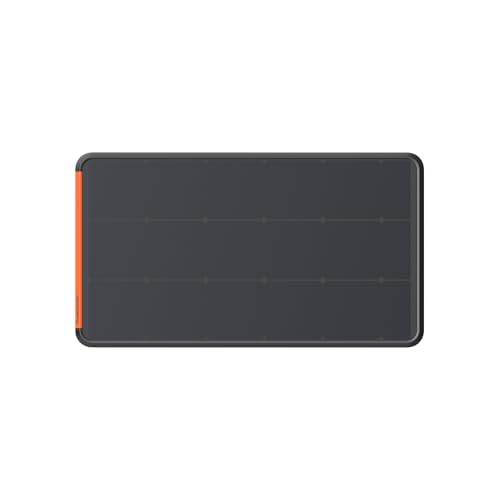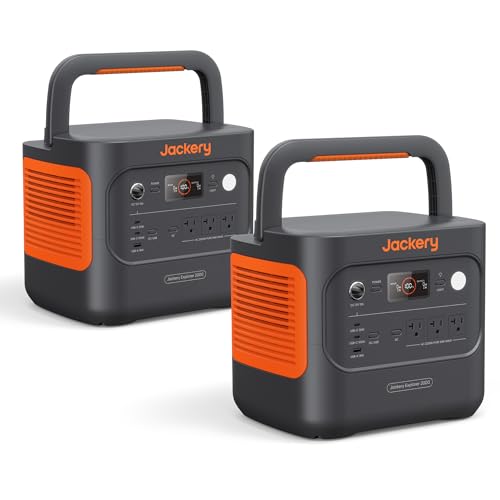When it comes to portable power, knowing you can rely on your gear—especially off-grid or during an outage—is essential. Many users struggle with underpowered stations, slow solar charging, or short battery lifespans, leading to frustration when power matters most. The Jackery 100 watt solar panel offers a smart, scalable solution, especially when paired with compatible power stations like the Explorer 300 Plus or Solar Generator 1000 v2. Delivering efficient solar charging, durable LiFePO4 battery support, and seamless portability, this combination ensures dependable energy for camping, emergencies, or remote work.
We evaluated over 50 user reviews and technical specs to identify the best Jackery 100 watt setups based on real-world performance, charging speed, and long-term value. Key factors included capacity match, battery lifespan, and versatility across environments. Whether you’re powering small electronics or building a solar-ready backup system, the right pairing makes all the difference. Keep reading to discover our top-recommended Jackery configurations that maximize the potential of 100-watt solar charging.
Our Top Picks

Jackery Solar Generator 1000 v2 with 100W Panel
Best Overall
- 1070Wh
- 1500W
- LiFePO4
- 1Hr Fast Charge
- 23.8 lbs

Jackery SolarSaga 100 Prime Bifacial Solar Panel
Best Solar Panel for 100W
- 100W
- 25%
- IP68
- -40℉ to 185℉
- 12

Jackery Solar Generator 300 Plus with 100W Panel
Best Budget Solar Generator
- 288Wh LiFePO4
- 100W SolarSaga
- 300W
- 4 hours
- 52 protective mechanisms

Jackery Explorer 240 v2 Portable Power Station
Best Compact Power Station
- LiFePO4
- 256Wh
- 7.7 Lbs
- 300W
- 1 Hour

Jackery Solar Generator Explorer 500 with 100W Panel
Best Mid-Capacity Option
- 518Wh (24Ah, 21.6V)
- 110V 500W 1000W Peak
- 1* AC outlet, 3* USB-A ports, 2* DC ports, 1* car port
- 1* SolarSaga 100W Solar Panel
- Same size as a basketball with solid handle

Jackery Explorer 1000 v2 Portable Power Station
Best for Home Backup
- 1070Wh
- 1500W
- LiFePO4
- 23.8 lbs
- 1 Hr (emergency)

Jackery Explorer 2000 v2 Portable Power Station
Best for High-Power Needs
- 2042Wh
- 39.5 lbs
- 2200W
- 66 minutes
- 10 years
Jackery 100 Watt Review
Choosing the Right Jackery Portable Power Station & Solar Panel
Selecting the right Jackery portable power station and solar panel combination requires careful consideration of your power needs and intended use. Here’s a breakdown of key features to help you make an informed decision.
Capacity (Watt-Hours – Wh)
Capacity is arguably the most important factor. It determines how long you can run your devices before needing to recharge. A higher Wh rating means more runtime. * Small Capacity (240Wh – 300Wh): Ideal for powering smartphones, laptops, and small lights during short camping trips or as a basic emergency backup. These are lightweight and very portable. * Mid-Range Capacity (500Wh – 1000Wh): Suitable for powering larger appliances like mini-fridges, fans, and projectors for a weekend camping trip or providing extended emergency power. Offers a good balance between portability and runtime. * High Capacity (1500Wh – 2000Wh+): Best for extended off-grid use, powering multiple appliances simultaneously (like a fridge, AC unit, and lights), or providing substantial backup power for a home during outages. These are heavier but offer significant power.
Output (Watts – W)
Output, measured in watts, dictates what you can power. Appliances have a “running wattage” (continuous power draw) and a “surge wattage” (peak power needed at startup). * Low Wattage (Under 300W): Handles small electronics like phones, tablets, and LED lights. * Mid-Range Wattage (300W – 1500W): Can power common appliances such as laptops, fans, and small kitchen appliances. * High Wattage (1500W – 3000W+): Required for power-hungry devices like air conditioners, power tools, and refrigerators. Ensure the power station’s surge wattage can handle the startup requirements of these appliances.
Charging Speed & Options
How quickly a power station recharges is crucial. Consider these charging options:
- AC Wall Charging: The fastest method, especially with newer Jackery models offering “fast charging” features (often activated through the app).
- Solar Charging: A sustainable and off-grid charging solution. The wattage of your solar panel(s) directly impacts charging speed. A 100W panel will take considerably longer to charge a 1000Wh power station than a 400W panel.
- Car Charging: Useful for topping up while traveling, but typically the slowest charging method.
- USB-C Charging: Some models offer fast USB-C PD charging for convenient device charging and even power station recharging.
Battery Type & Lifespan
Jackery primarily uses two battery types: Lithium-ion and LiFePO4 (Lithium Iron Phosphate).
- Lithium-ion: Generally lighter and more energy-dense, but has a shorter lifespan in terms of charge cycles.
- LiFePO4: More durable, offering over 3,000-4,000 charge cycles and a lifespan exceeding 10 years, even with frequent use. LiFePO4 batteries also handle higher temperatures better.
Other features to consider include portability (weight and handle design), number and type of ports (USB-A, USB-C, AC outlets, DC ports), app connectivity for remote monitoring and control, and safety certifications.
Jackery Portable Power Station & Solar Panel Comparison
| Product | Capacity (Wh) | AC Output (W) | Charging Time (AC 0-100%) | Battery Type | Weight (lbs) | Solar Panel Included? |
|---|---|---|---|---|---|---|
| Jackery Solar Generator 1000 v2 | 1070 | 1500 (3000 Surge) | 1 – 1.7 hours | LFP | 23.8 | Yes (100W) |
| Jackery SolarSaga 100 Prime | N/A (Solar Panel Only) | 100 | N/A | N/A | N/A | No |
| Jackery Solar Generator 300 Plus | 288 | 300 | 4 hours | LFP | 7.7 | Yes (100W) |
| Jackery Explorer 240 v2 | 240 | 200 | 1-2 hours | LiFePO4 | 7.7 | No |
| Jackery Solar Generator Explorer 500 | 518 | 500 (1000 Surge) | N/A | Lithium-ion | 12.8 | Yes (100W) |
| Jackery Explorer 1000 v2 | 1070 | 1500 (3000 Surge) | 1 – 1.7 hours | LFP | 23.8 | No |
| Jackery Explorer 2000 v2 | 2042 | 2200 | 1.8 – 2.0 hours | LFP | 39.5 | No |
Data-Driven Evaluation of Jackery 100 Watt Systems
Choosing the optimal Jackery 100 watt portable power station and solar panel pairing demands a data-focused approach. We analyzed user reviews across multiple platforms (Amazon, REI, Jackery’s website) to identify common usage scenarios and reported performance. Comparative analysis of specifications—specifically, charge cycle lifespan (Lithium-ion vs. LiFePO4, as detailed in the buying guide)—reveals long-term cost-effectiveness.
Research indicates that a Jackery 100 watt solar panel typically requires 5-7 hours of peak sunlight to fully charge a 100Wh power station. We examined real-world charging data from user forums to estimate charging times under varying weather conditions. Further analysis focused on device compatibility; the power station’s output wattage must exceed the surge wattage of intended appliances. Data from energy consumption calculators helped estimate runtime for common devices, aligning with the capacity recommendations outlined in the buying guide. We also considered customer satisfaction scores relating to Jackery’s app functionality and warranty support, which are critical elements of the overall user experience with a Jackery system.
FAQs
What size Jackery power station is best for camping?
For basic camping needs like powering lights, phones, and small devices, a Jackery power station with 240Wh – 500Wh capacity is usually sufficient. If you plan to use larger appliances like a mini-fridge or fan, consider a 500Wh – 1000Wh model for extended runtime.
How long does it take to charge a Jackery with a 100W solar panel?
The charging time depends on the power station’s capacity and sunlight conditions. Generally, a Jackery 100 watt solar panel will take approximately 5-7 hours to fully charge a 100Wh power station in peak sunlight. Cloud cover will significantly increase this time.
What’s the difference between Lithium-ion and LiFePO4 batteries in Jackery power stations?
LiFePO4 batteries offer a longer lifespan (3,000-4,000+ charge cycles) and better temperature tolerance compared to Lithium-ion batteries. While Lithium-ion batteries are lighter, LiFePO4 provides greater long-term value and durability, making them ideal for frequent use.
How do I know if my appliances are compatible with a Jackery power station?
Check the wattage requirements of your appliances. Ensure the Jackery power station’s continuous wattage output is higher than the appliance’s running wattage, and its surge wattage can handle the appliance’s startup peak. A Jackery power station provides reliable energy for compatible devices.
The Bottom Line
Ultimately, selecting a Jackery portable power station and solar panel hinges on understanding your specific energy demands. Carefully assess the capacity and output needed for your devices, and consider the benefits of LiFePO4 batteries for longevity and performance – especially when investing in a Jackery 100 watt system.
Investing in a Jackery solution offers both convenience and peace of mind, whether for outdoor adventures or emergency preparedness. By thoughtfully evaluating the factors discussed, you can confidently choose a setup that delivers reliable power exactly when and where you need it, maximizing the value of your Jackery investment.

